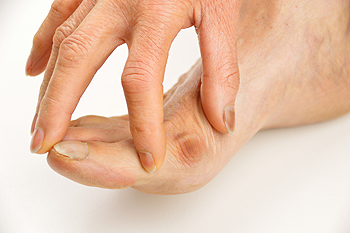
Kevin F Gallagher, DPM
Board Certified in Foot and Ankle Surgery
(724) 941-4330

Kevin F Gallagher, DPM
Board Certified in Foot and Ankle Surgery
(724) 941-4330
 One of the most common forefoot issues is a bunion. This occurs when there is a bump on the inside of the foot near the big toe joint and the big toe begins moving towards, and potentially overlapping with, the smaller toes. Another type of bunion that can occur is a tailor’s bunion, also known as a bunionette. A tailor’s bunion occurs on the pinky toe. While bunions can form due to issues with foot function, such as arthritis, improperly fitting footwear tends to be the most common cause. Shoes that are too tight and squeeze the toes together generally lead the first metatarsal bone to protrude on the side of the foot. Because of this, wearing shoes with a wide toe box is usually recommended. Those who are suffering from a painful bunion should visit a podiatrist for proper treatment. Treatment options may include orthotics, and in severe cases, surgery may be suggested.
One of the most common forefoot issues is a bunion. This occurs when there is a bump on the inside of the foot near the big toe joint and the big toe begins moving towards, and potentially overlapping with, the smaller toes. Another type of bunion that can occur is a tailor’s bunion, also known as a bunionette. A tailor’s bunion occurs on the pinky toe. While bunions can form due to issues with foot function, such as arthritis, improperly fitting footwear tends to be the most common cause. Shoes that are too tight and squeeze the toes together generally lead the first metatarsal bone to protrude on the side of the foot. Because of this, wearing shoes with a wide toe box is usually recommended. Those who are suffering from a painful bunion should visit a podiatrist for proper treatment. Treatment options may include orthotics, and in severe cases, surgery may be suggested.
If you are suffering from bunion pain, contact Dr. Kevin F. Gallagher of Gallagher Podiatry. Our doctor can provide the care you need to keep you pain-free and on your feet.
What Is a Bunion?
Bunions are painful bony bumps that usually develop on the inside of the foot at the joint of the big toe. As the deformity increases over time, it may become painful to walk and wear shoes. Women are more likely to exacerbate existing bunions since they often wear tight, narrow shoes that shift their toes together. Bunion pain can be relieved by wearing wider shoes with enough room for the toes.
Causes
Symptoms
In order to diagnose your bunion, your podiatrist may ask about your medical history, symptoms, and general health. Your doctor might also order an x-ray to take a closer look at your feet. Nonsurgical treatment options include orthotics, padding, icing, changes in footwear, and medication. If nonsurgical treatments don’t alleviate your bunion pain, surgery may be necessary.
If you have any questions, please feel free to contact one of our offices located in McMurray and Hickory, PA . We offer the newest diagnostic and treatment technologies for all your foot care needs.